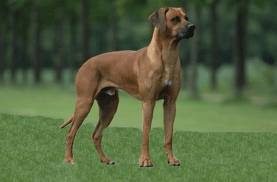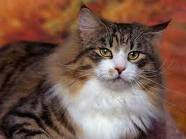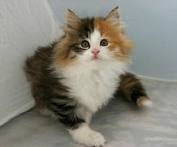The Delicate Persian Cat
amongst quite possibly the most well-liked of cat breeds and they are also the longest known pedigree cats. Many of them tend for being white but they basically exist in a very number of colors and patterns. The breed has all around sixty different colour variations.
 |
| Persian Cat Breeds |
Traits In the Persian Cat Breed
Persian cats are famous as a result of the very long hair and entire body kind. These cats have flat faces, smaller ears, quick noses and extensive chests. Their legs are durable with big paws.
Quite possibly the most exceptional trait of those cats is their thick, gentle coat of fur that has a ruff around the neck, in addition to a tail that hangs quite lower. These cats really are a extremely high-priced breed of cat and are available in different types.
Good Demonstrate Cats
These cats are sometimes observed participating in cat competitions, exactly where these are separated into seven diverse groups depending on colour. These colors are reliable, bicolour, shaded, tabby, silver, gold, smoke and Himalayan. They get noticed for their extended, flowing coat and also their colour.
Beneficial Companions
Persian cats are favorite because they have quite mild personalities. These are amazing companions to have and may be best as pets for youngsters simply because they are incredibly minimal servicing and may for that reason easily be looked right after. They don’t call for many focus but they do enjoy being playful and affectionate. Persian cats are really vocal and can communicate perfectly using their gentle, pleasing voice in addition to their eyes. These are not as well active and do not jump or climb as considerably as other cats to. They are inclined to like spending plenty of time lounging all-around and currently being admired.
Indoor Cats
Persian cats are very best kept inside the house therefore you can shield their pretty coats. Going outdoors can conveniently damage their coats, and may also make the cats vulnerable to ailments and typical parasites. Grooming Persian cats is definitely the only servicing they need as they can not maintain their very own coats like most other breeds of cat. This can be timely function, for the reason that their fur is dense and pretty lengthy. It demands to get brushed each day utilizing a metal comb, otherwise their coat stands to have tangled up in hairballs, and it ends up hunting oily and shedding its shine.
They Have to have Standard Baths
Not like most other cats, you will end up shocked to find out that you just also really need to bathe this breed of cat often to be able to keep its coat thoroughly clean, healthy and balanced and browsing its finest. They also need to be dried fully following their baths. Looking to bathe a completely grown Persian cat will be a troublesome and very challenging activity, so commence bathing it like a kitten to obtain them utilized to savoring their common baths.
 |
| Persian Cat |
Persians, with their extended flowing coats and open pansy-like faces are classified as the number 1 breed in reputation, and maybe by far the most recognisable. Though many people are unable to name more than a number of cat breeds, pretty much all of them might be able to name the Persian.
It can be said that the forerunners of today's Persians were brought back by seventeenth century European explorers alongside jewels, silks and spices from faraway Persia. Other longhaired cats came from Turkey and ended up classed as Angora. Regarded as luxuries, they soon became the feline position symbol on the elite. These cats had been named Persian for his or her nation of origin, but hieroglyphic references of this breed as early as 1684 BC include uncertainty to their correct beginnings.
The Persian is a seriously boned, well-balanced cat with a sweet expression and soft, spherical lines. Inspite of their hefty look, Persians move with an surprising agility. The Persian also sports an extended, flowing coat draped on a compact, chunky, short human body referred as "cobby" supported by brief, thick legs. Large round eyes set extensive apart in the substantial spherical head with smaller wide-spaced rounded ears contribute towards the total appear and expression. A broad, sweeping brush of the tail as wide since the human body completes the picture.
The Persian's beautiful coat is extended and thick, standing away from the physique. An immense ruff continues in a deep frill involving the cat's front legs. Suitable servicing with the coat involves a day-to-day run-through using a metal comb to eliminate the prospective disadvantages of tangles and hairballs. Occasional bathing is expected to keep the coat thoroughly clean, healthful and stunning. Time and commitment to some day by day grooming regimen is expected of your Persian proprietors, and most will get pleasure from this good quality time shell out with their cats.
Persians adapt nicely to an indoor natural environment and are frequently peaceful, tranquil and thoroughly laid-back. Their sweet and delicate personalities blend nicely into most households. Their tranquil, melodious voices are pleasant and non-abrasive. They talk delightfully with their big expressive eyes and make charming pets for all ages. They are also incredibly affectionate and loving cats always responsive to their humans. Even though placid, Persian are playful within their private way. The gentle Persian is a frequent source of joy and delight to their people and make amazing, near and
The Persian's lovely coat comes in a wide range of colors and designs, which includes parti-colours, bi-colours, shadeds, smokes, solids and tabbies. Persians are divided into 7 color divisions for the intent of competition. These divisions are established in the foundation from the colour pattern. Huge, round owl-like eyes are found in a rainbow of colors with eye colour pertinent to your Persian color divisions.
 |
| The Delicate Persian Cat |
Organisations
Persian Cat Club Club devoted to the Persian Cat.
Persian-cats.com Persian Cat facts, pictures and inbound links.
Blue Persian Cat Society Initially and oldest Longhair cat club inside globe.
United Silver Fanciers International CFA cat club dedicated with the Silver Persian.
Longhair and Semi-Longhair Cat Club Cat Club devoted to Persians Cats and other Semi-Longhairs.
Breed Training books
Manual to Owning a Persian Cat by Juliet Seymour.
Persian Cats by Edward Essarde.
Persian Cats by Marianne Mays.
Persian Cats together with other Lengthy Hairs by Jeanne Alice Ramsdale.
The Persian Cat by Joanne Mattern.
 |
| Persian Cat Breeds |

























